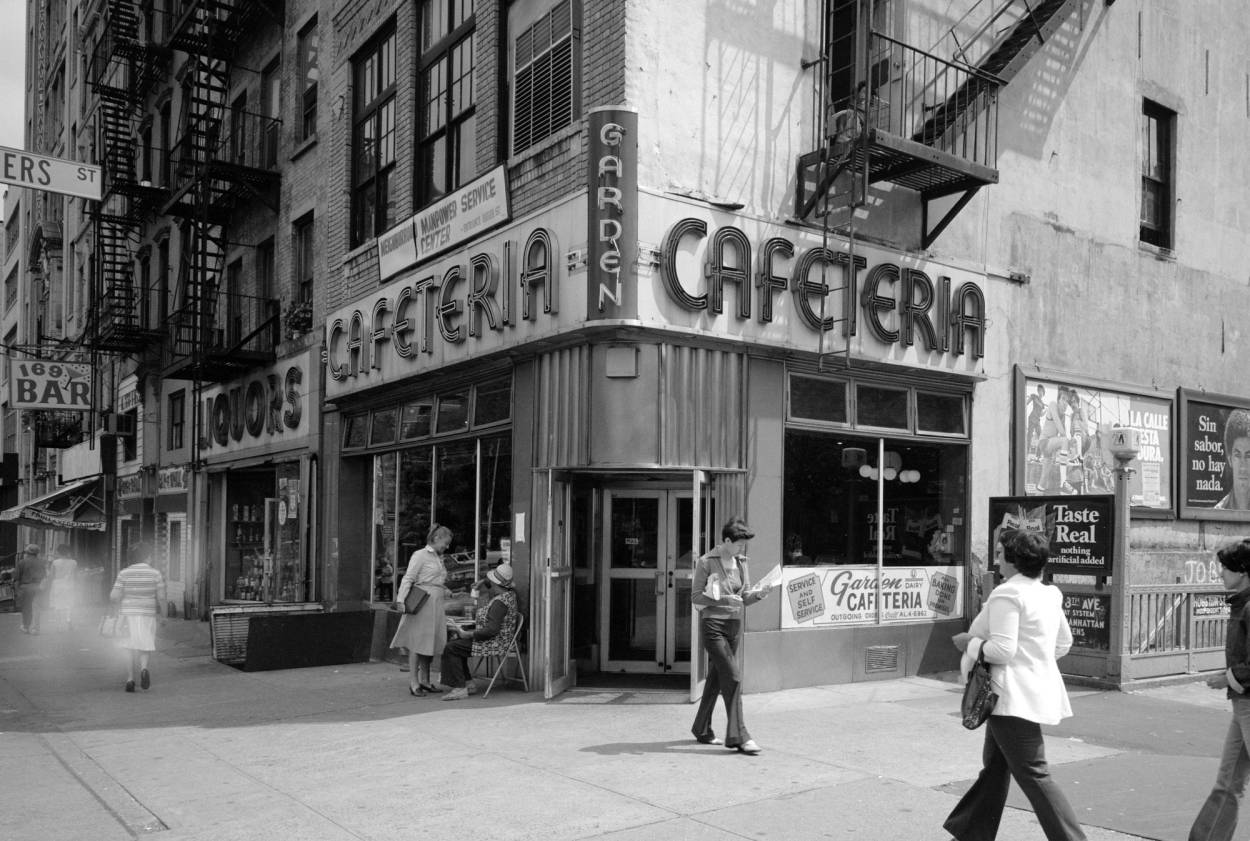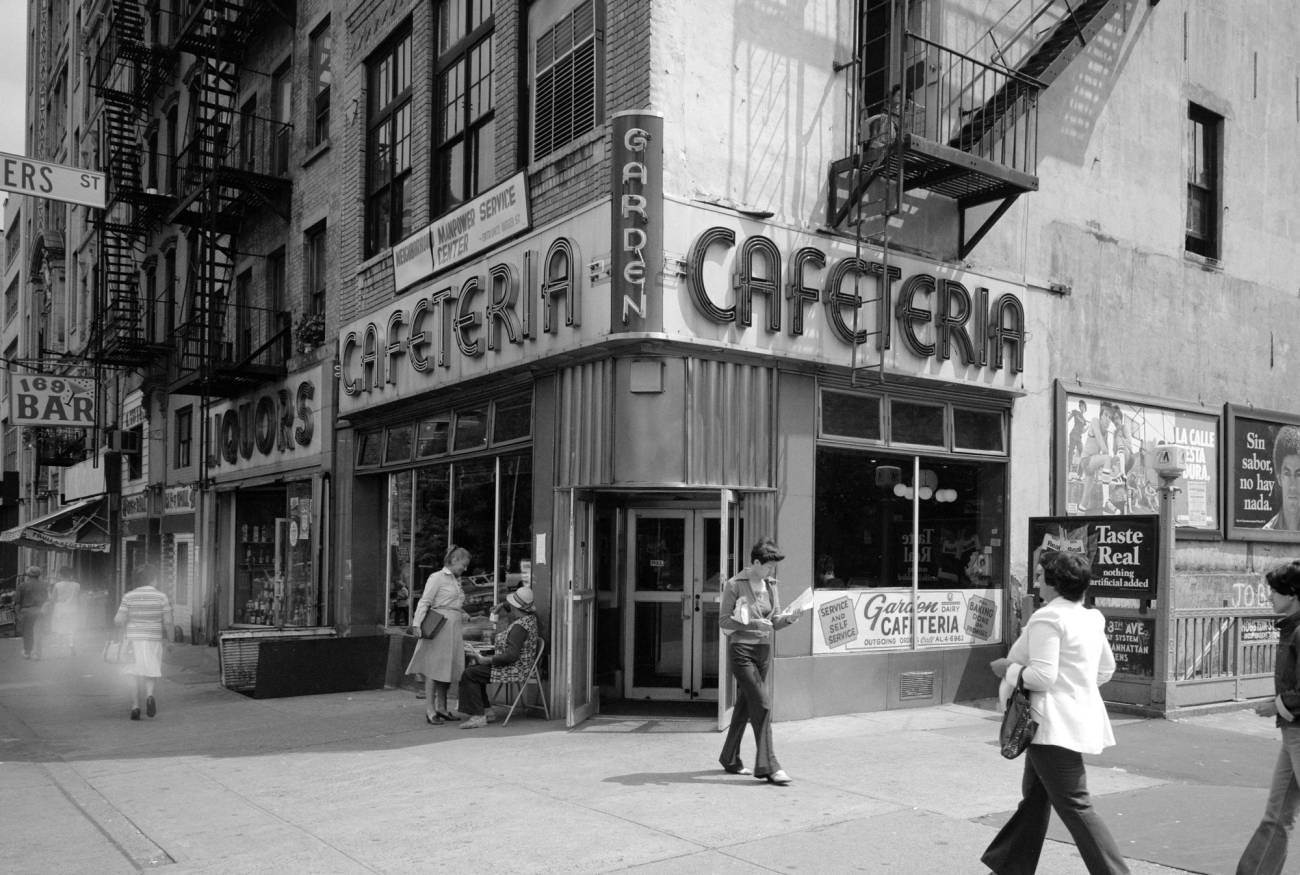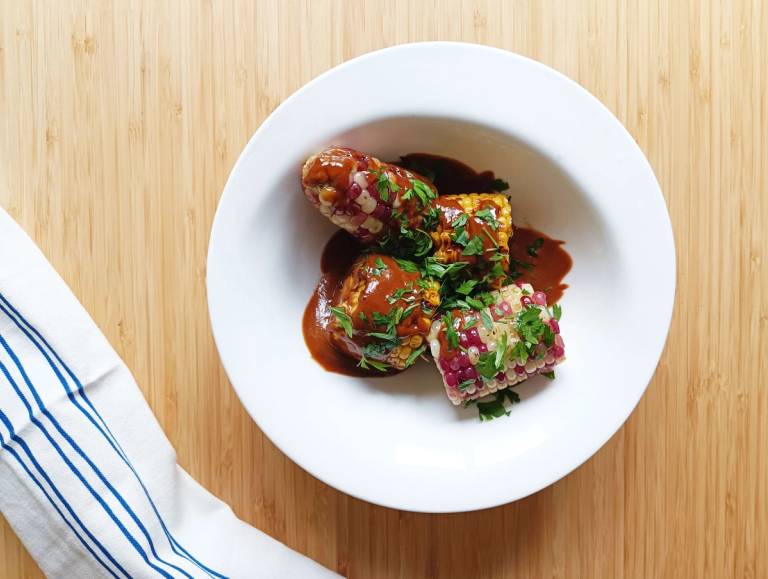On a crisp April morning at the intersection of Rutgers Street and East Broadway in Manhattan, Elise Lovaas, a tour guide with the Tenement Museum, remarked somberly to a man named Rob, “It’s all gone.” A 78-year-old Jewish New Yorker who had relocated to Florida in the late 1990s, Rob hadn’t set foot on the Lower East Side in over four decades until he signed up for Lovaas’ tour. He was deeply moved, verklempt even, to see how much of the Jewish enclave he remembered fondly had been absorbed into the annals of history.
“I really was looking forward to have a good old cup of coffee here,” Rob told me, while gazing through the windows of what was once the epicenter of Jewish intellectualism on Manhattan’s Lower East Side. Yet, the nostalgic mensch wasn’t referring to the renowned Forward Building, the 1912 beaux-arts masterpiece that housed the offices of the Forverts, the pivotal Yiddish paper of the Jewish labor movement. Instead, his nostalgia was for the Garden Cafeteria a few doors down at 165 East Broadway.
In an era when Yiddish newspapers were a daily fixture and their Yiddish-speaking readers thronged the streets, the Garden Cafeteria stood as a nexus, much like the renowned Café Royal on Second Avenue in the 1920s. A self-service eatery offering an array of kosher delicacies, Garden beckoned Jewish intellectuals and the spirited neighborhood folk alike. Among its regular habituès were Emma Goldman, Elie Wiesel, and the Nobel laureate Isaac Bashevis Singer, who drew inspiration from the establishment for his short story “The Cabalist of East Broadway.”
“The Garden Cafeteria was my second home,” Singer wrote once. “I ate there and discussed literature with my literary chums, gossiped about publishers, editors, and especially about the critics who didn’t like us and whom we disliked. We also questioned the very purpose of literature. What can it do? What has it done in the past? What can one expect it to do in the future? To strengthen our arguments we ate mountains of rice pudding and drank countless cups of coffee.”
Before New York City’s coffeehouses became the egalitarian meeting grounds for intellectuals—both recognized and emerging—and played a pivotal role in bridging the city, Jewish immigrants, including numerous Jewish writers, poets, historians, and artists, had already tasted the liberating ambiance of similar European establishments. Several decades earlier, beginning during the Enlightenment era, these creative minds had unlocked the freedoms and advantages inherent in these urban hubs, all while sipping coffee.
“Coffehouses served as a modern replacement for traditional beit midrash [Jewish house of study],” said Shachar Pinsker, author of A Rich Brew: How Cafés Created Modern Jewish Culture. “They became a second home and offered Jews a refuge from the anonymity of urban life. These places were inexpensive, democratic, and inclusive. But, most importantly, Jews were welcome here, unlike other most non-Jewish social and ethnic clubs.”
From the bustling lanes of Odessa and Warsaw to the refined boulevards of Vienna, Berlin, and even Tel Aviv, cafés played a pivotal role in the Jewish experience of the late 19th and early and mid 20th centuries as Europe underwent a wave of intellectual awakening. This epoch marked a significant shift in European societies, with Jewish communities receiving a warmer welcome in many regions.
This was a transformative period marked by migration, assimilation, and urban growth. In these establishments, Jews seamlessly mingled with non-Jews, absorbing and contributing to secular culture. Through exposure to diverse media—from the press, to literature, theater, art, philosophy, and politics—Jewish patrons and leading intellectuals integrated broader societal facets into their own unique cultural and social fabric.
Those Old World cafés, which began popping up in Europe in the 18th century, were small in number, but were nevertheless significant. Not only were they social gathering places, they became street-level emporiums that nurtured a mentality, characterized not only by joie de vivre but also associated with Jewishness. So much so that in Austria, where das Wiener Kaffeehaus was listed as a protected intangible cultural heritage site by UNESCO, coffeehouses were seen by the Viennese as an inherently “Jewish space.”
During this vibrant era, Berlin became the creative hub for numerous notable Jewish émigré artists from Eastern Europe. Here, the Romanisches Café emerged as an emblem of the city’s soaring modernity and stood as a testament to the growing divide between Yiddish and Hebrew writers and their broader Jewish readership. The city occupied a distinguished place in Jewish culture over a long period from the 18th century to the rise of the Nazis. Marc Chagall, who set foot in Berlin in 1922, once remarked, “Never in my life have I encountered as many enigmatic Hasidic rabbis as in the inflationary streets of Berlin, nor seen such a congregation of constructivist artists as at the Romanisches Café.”
There were many cities where Jews congregated, moved from, and traveled between. The Jewish community of Warsaw grew from 15,600 in 1816 to 72,800 in 1864. Economic opportunities, political developments, escape from persecution, and a common shift in rural economic conditions are among the chief reasons cited for the massive migration of Jews to cities in the 19th and 20th centuries.
“With the migration from rural to urban regions, they offered sanctuaries, and became third spaces, besides their home and synagogue,” Pinsker said of the European cafés.
In the bustling cities, coffeehouses became more than just venues for intellectual discourse and entertainment for many Jewish individuals. As they transitioned from rural settings to urban landscapes, these establishments provided essential services, becoming lifelines where they could sustain themselves.
“Sociability in the cafés wasn’t merely a product of leisure but a necessity driven by both economic and socio-cultural factors,” noted Dеlphinе Bесhtеl, a Senior Lecturer and Researcher of Eastern, Balkan, and Central Europe Cultures at Sorbonne University in Paris. “With half of the city apartments lacking basic amenities like electricity and sewage, these cafés seamlessly transformed into living rooms, dining areas, reading spaces, and even offices.”
The creation of urban cafés has been recognized as playing an imperative role in the creation of European modernism, which later was brought to the Americas and played a pivotal role in the development and construction of culture, intellectualism, and bohemia in cities like New York. By using the café, and writings about the café, as the focal point of such constellations of moments and spaces, we see how Jewish culture and modernism emerged side by side, each shaping and being shaped by the other.
According to Pinsker, Jewish modernity was born in the café, nourished, and sent out into the world by way of print, politics, literature, art, and theater. What these Jewish individuals experienced and created in the coffeehouse, as a multilingual and transnational space, touched thousands who read, saw, and imbibed a modern culture that redefined what it meant to be a Jew in the world.
In emerging cities like Warsaw, the presence of Jewish writers and intellectuals in cafés became more common and more pronounced in the last decades of the 19th century.
Regarding Lemberg (current Lviv, Ukraine) in 1910, Galician historian Franciszek Jaworski observed: “In the half-light of the cafés live whole groups of people, forming a characteristic and peculiar society, eager for nervous agitation and European breath, revelling in columns of printed paper, insatiable of the gossip of the big city, and above all of sparkling life, waves of vibrant light, arabesques of smoke, amid calls hailing waiters.”
The genesis of coffee—or more accurately qishr, a brew made from the husks of the coffee plant and not its beans—took place in Ethiopia. This early iteration of the beverage made its way to Yemen, and by the closing years of the 15th century, coffee beans and the drinks crafted from them had found enthusiasts in Mecca, Medina, Cairo, and Istanbul. By 1554, two enterprising traders from Aleppo and Damascus were credited with opening the premier coffeehouses in the Ottoman Empire, sprinkled across the cities of Anatolia. These establishments eventually came to be affectionately termed as the “schools of the wise.”
When tales of this invigorating drink reached European shores in 1582, coffee swiftly became a symbol of social interaction. The meticulous art of roasting and brewing the beans transformed coffeehouses into sought-after destinations, revered in the Islamic world as “taverns without wine.”
Yet, like any novelty, coffee’s reception was a tapestry of varied opinions. While some found its taste disagreeable, its energizing properties were universally acknowledged. In religious circles, the beverage faced scrutiny and debate. The luminous kabbalist Isaac Luria deemed coffee consumption forbidden. In stark contrast, Italian Rabbi Hezekiah da Silva, opining in the late 1600s, asserted, “One cannot attain presence of mind without the aid of coffee.”
As coffee’s presence deepened, Jewish legal inquiries emerged. Rabbinical authorities grappled with defining its role, especially when coffee was seen as a “totally new thing that did not exist previously,” as historian Robert Liberles notes in Jews Welcome Coffee: Tradition and Innovation in Early Modern Germany. Austrian Rabbi Jacob Reischer, in his compilation of Jewish responsa, Shvut Yaakov, deliberated on various facets, from the permissibility of Jews consuming coffee made by a gentile on Shabbat to its status during Passover in light of prohibitions on legumes. Reischer’s stance was progressive: If a Jew ground the coffee beans prior to Passover, consumption was permissible.
Tracing the evolution of coffee and café culture, the role of Jews is both profound and expansive. In 1632, Europe saw its first coffeehouse sprout in Livorno, Italy, courtesy of a Jewish entrepreneur. The influence continued when, in 1650, a Lebanese individual fondly known as “Jacob the Jew” introduced the English to their first coffeehouse in Oxford. This wave of innovation soon saw Sephardic Jews partnering with Armenian and Greek merchants, leading to the inception of coffeehouses in the Netherlands and France.
By the 18th century, the allure of exotic commodities like coffee, tobacco, sugar, and chocolate was rising. Among these, coffee stood out for the Jewish community, as its trade was not explicitly forbidden. Jews swiftly recognized this and embarked on coffee commerce. Their influence resonated in America, where the aftermath of the Boston Tea Party transformed coffee into a patriotic drink.
When Jewish immigrants from Europe settled in America during the 19th century, they carried with them a sweet legacy: the coffee cake. Rooted in German kaffeekuchen and streussel traditions, this delicacy soon overtook the English tea cake in popularity. As coffee evolved into a symbol of affluence and luxury, prominent Jewish merchants, aiming to align with the elite, became early aficionados of this beverage. The seaport cities of America witnessed several Jewish traders specializing in coffee.
Historically speaking, some of New York’s colonial-era coffeehouses like the Exchange Coffee House, the Merchants’ Coffee House, and Tontine Coffee House were hubs of commerce. Jewish merchants frequented these places, which played crucial roles in their community. Notably, in 1826, the first synagogue building of Congregation B’nai Jeshurun was procured at an auction held at the Tontine Coffee House, a site that would later give rise to the New York Stock Exchange.
Several Jewish families ventured into the coffee business during this period. The Shoenholts established the Gillies Coffee Company in 1840. Other notables included Joseph Martinson with his eponymous brand, Samuel Schonbrunn whose Savarin brand graced the Waldorf-Astoria Hotel, and William Black whose ventures metamorphosed into the famed Chock full o’Nuts coffee shops.
As the competition for the coffee market heated up, a discerning entrepreneur, Joseph Jacobs, came into the spotlight. Owning New York’s first Jewish advertising agency, he took on Maxwell House Coffee Company as a client. Dismissing a misconception that coffee beans were inedible during Passover, Jacobs sought validation from an Orthodox rabbi, ensuring Maxwell House coffee’s kosher status. This collaboration led to a seminal advertising move in 1932 when Maxwell House began distributing free Haggadot adorned with illustrations and advertisements. The campaign still runs, with over 60 million copies distributed to date.
Beyond trading, Jews significantly impacted how coffee was served. This influence is epitomized by the Anthora paper cup—a ubiquitous sight for New York coffee drinkers for decades. This iconic design was conceived 50 years ago by Leslie Buck, a Holocaust survivor, targeting the Greek-owned diners in the city.
Forty years ago, the Garden Cafeteria sold its last rice pudding and closed after 42 years on May 1983. The vibrant, discussion-rich coffeehouses that once dotted our cities seem to be a relic of the past. Though establishments like Blank Street Coffee and Starbucks are more accessible now—their modern incarnation offers a starkly different ambiance. Today’s coffee shops serve primarily as pit stops to grab a caffeine fix or a quick bite for most of its denizens. Yes, they may sometimes double as spaces for casual chats or as the backdrop for aspiring writers channelling the aura of 1990s cinema, often punctuated with frequent Instagram checks and free Wi-Fi indulgences. The shift is undeniable, and with technology’s unrelenting march, it’s uncertain if the vibrant café culture of yesteryear will ever return in its erstwhile form. Yet, amid this evolution, one thing remains indelible: the enduring heritage of Jewish life on the Lower East Side, the contribution of merchant Jews, and the lasting contributions of Jewish intelligentsia. This legacy stands tall, impervious to the luxury condos and trendy bars that now rise from its historic grounds.


